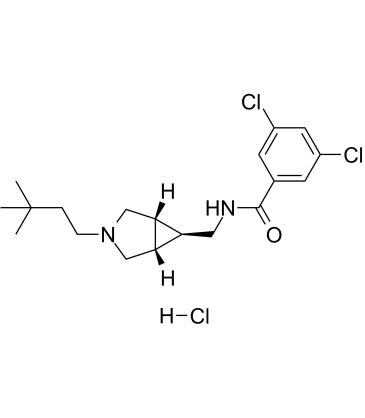| Description |
ML218 hydrochloride is a potent, selective and orally active T-type Ca2+ channels (Cav3.1, Cav3.2, Cav3.3) inhibitor with IC50s of 310 nM and 270 nM for Cav3.2 and Cav3.3, respectively. ML218 hydrochloride inhibits the burst activity in subthalamic nucleus (STN) neurons. ML218 hydrochloride has no significant inhibition of L- or N-type calcium channels, KATP or hERG potassium channels. ML218 hydrochloride can penetrate the blood-brain barrier[1].
|
| Related Catalog |
|
| Target |
IC50: 310 nM (Cav3.2), 270 nM (Cav3.3), and 150 nM (Ca2+ flux)[1]
|
| In Vitro |
In plasma protein binding studies (equilibrium dialysis), ML218 possesses good free fraction in both rat and human. Intrinsic clearance experiments in liver microsomes indicated that ML218 is highly cleared in rat (CLint = 115 mL/min/kg), but low to moderately cleared in human liver microsomes (CLint = 12.7 mL/min/kg)[1].
|
| In Vivo |
ML218 (0.03-30 mg/kg; oral administration; once; male Sprague-Dawley rats) treatment reverses cataleptic behavior in rats induced by a 0.75 mg/kg dose of haloperidol[1]. Free brain and plasma concentrations of ML218 increases in a dose proportional manner across the dose range (3 mg/kg: [plasma] = 98 nM, [brain] = 1.66 μM; 10 mg/kg: [plasma] = 282 nM, [brain] = 5.03 μM; 30 mg/kg: 1.2 μM, [brain] = 17.7 μM)[1]. Noncompartmental pharmacokinetic analysis indicates ML218 (1 mg/kg, IV) has a mean residence time (MRT) of nearly 7 h, a value which is consistent with its terminal half-life (t1/2 = 7 h)[1]. Animal Model: Male Sprague-Dawley rats (275-299 g) induced by haloperidol[1] Dosage: 0.03 mg/kg, 0.1 mg/kg, 0.3 mg/kg, 1 mg/kg, 3 mg/kg, 10 mg/kg, 30 mg/kg Administration: Oral administration; once Result: Reversed cataleptic behavior in rats induced by a 0.75 mg/kg dose of haloperidol.
|
| References |
[1]. Xiang Z, et al. The Discovery and Characterization of ML218: A Novel, Centrally Active T-Type Calcium Channel Inhibitor with Robust Effects in STN Neurons and in a Rodent Model of Parkinson's Disease. ACS Chem Neurosci. 2011 Dec 21;2(12):730-742.
|
